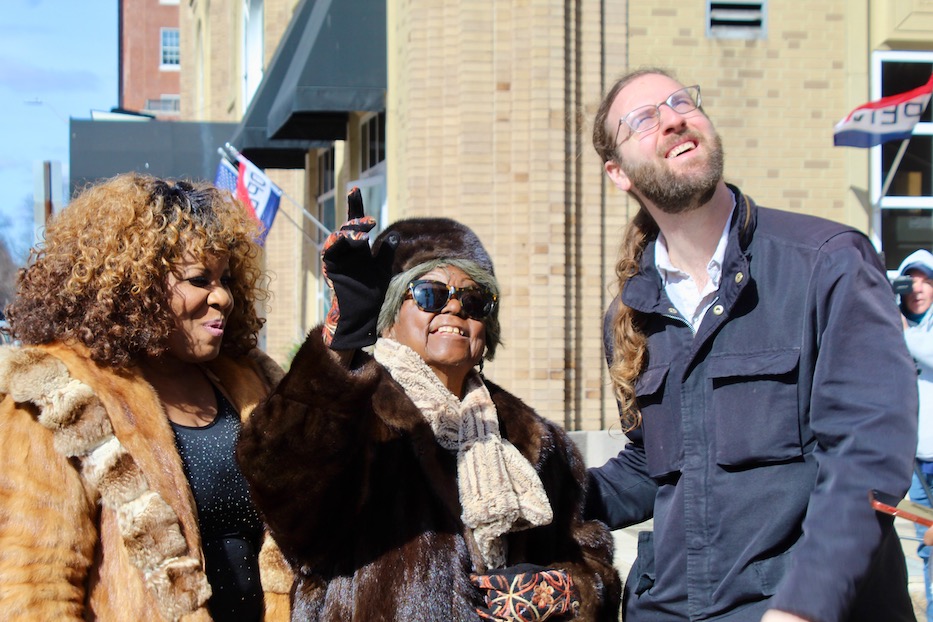
Black History Month | Culture & Community | Arts & Culture | Community Heroes | History
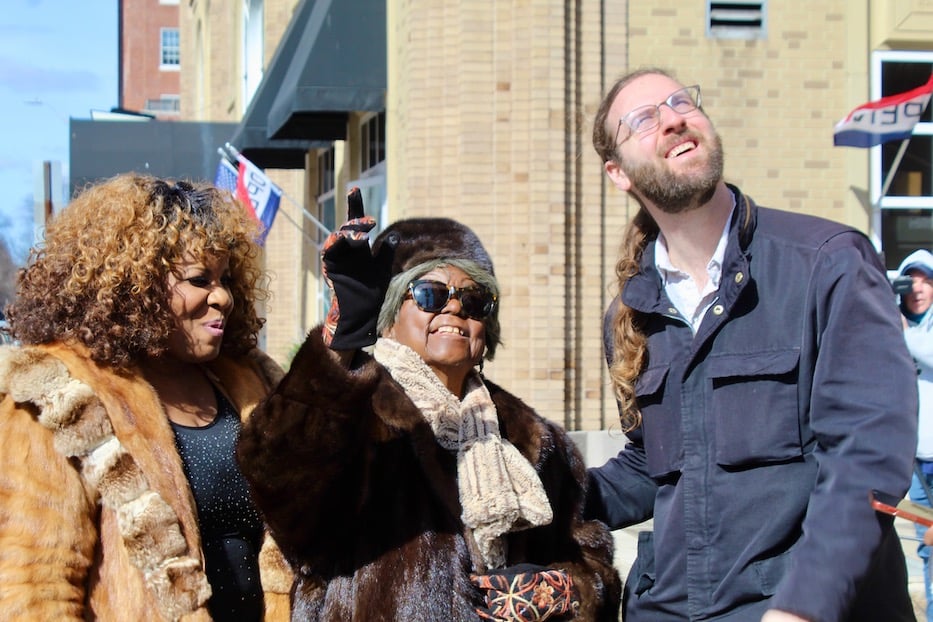
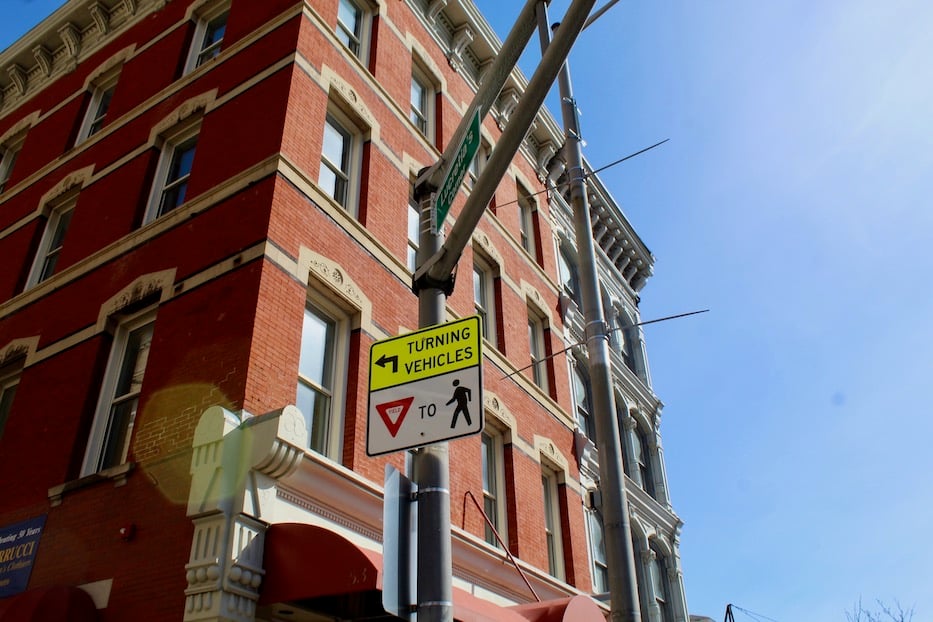
Top: Trina Green, Dr. Ann Garrett Robinson, and Steve Winter. Bottom: The corner, moments after unveiling. Lucy Gellman Photos.
It took four centuries, 25 years of research, and over a decade of citywide advocacy. But Lucretia is finally getting her due.
Advocates, city officials, everyday historians and dozens of students gathered on Elm Street Monday morning to celebrate the long-awaited naming of “Lucretia’s Corner,” honoring the first recorded Black resident of New Haven. During her lifetime, Lucretia was enslaved by Theophilus Eaton, who governed New Haven when it was still under British colonial rule.
His home stood at the Northeast corner of Orange and Elm Streets, where a building filled with law offices, a hat shop, and two news outlets—and a newly named corner—now stands.
It is owing to the years-long labor and research of Dr. Ann Garrett Robinson, a retired psychology professor and longtime champion of New Haven who first discovered Lucretia’s name 25 years ago, in a document buried in the research papers of the Greater New Haven African American Historical Society. Monday, she thanked city officials for recognizing—and reckoning with—some of New Haven’s earliest history.
"I love New Haven, and I love New Haven history," Robinson said Monday, surrounded by friends and neighbors who helped her collect signatures to rename the corner. “This corner proves, undoubtedly, that we can work together. That it is a situation where there were slaves, owners, we went through a war, and look where we are now. We’re here, getting ready to honor Lucretia.”
“I believe we’re doing what God wants us to do,” she later added. After an outdoor renaming ceremony that drew dozens, festivities continued for nearly two hours at City Hall.
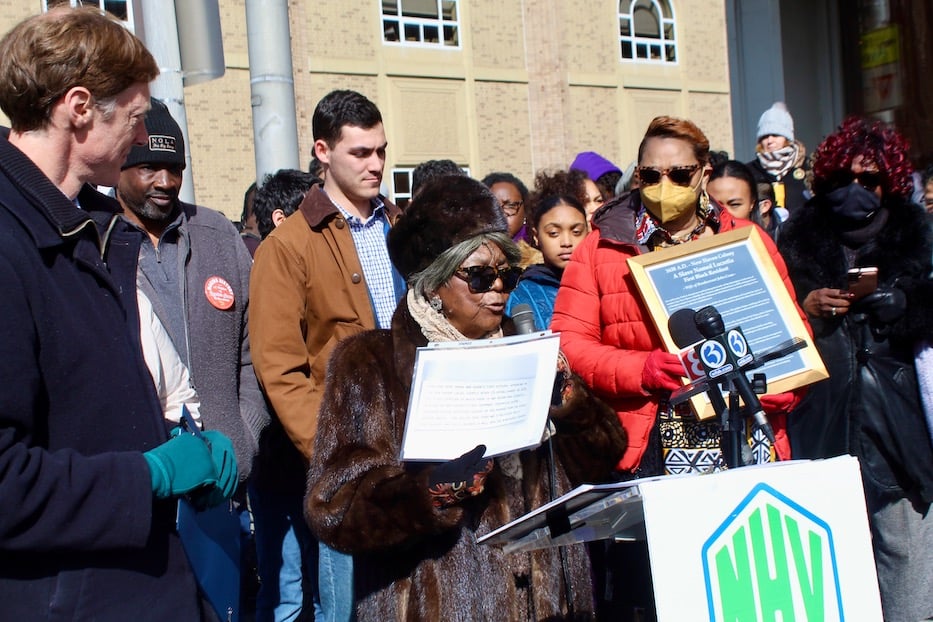
Dr. Ann Garrett Robinson with the document that sent her on a research journey 25 years ago. “I believe we’re doing what God wants us to do,” she said Monday.
The moment has been a quarter of a century—and some might argue, 385 years—in the making. The first record of Lucretia is from 1638, when Eaton arrived in what is now recognized as New Haven. In the city, which was then part of the New Haven Colony, he enslaved at least three people. According to author Wendy Warren’s book New England Bound: Slavery and Colonization in Early America, their names were Anthony, John Whan (some sources have him listed as John Cram), and his wife, Lucretia.
That was nearly four centuries ago. Then in 1997, Robinson—who worked for years as a professor at Gateway Community College—was doing research in New Haven’s Black history when she found an early mention of Lucretia. She followed the history, discovering that Lucretia was an activist in her own right, particularly for protection and caretaking of the elderly. She found that Lucretia was likely freed at some point, although she does not know when.
A decade ago, Robinson introduced readers to this little-known New Haven resident through guest contributions in the New Haven Register. Then around 2018, she also enlisted the help of now-former Newhallville Alder Steve Winter to spearhead corner renaming efforts. Two hundred and fifty signatures and a vote from the New Haven Board of Alders later, the corner became official. Her research and quest for recognition is also the subject of Lucretia Was Here: 1638, a series of black-and-white photographs from New Havener Katrina Goldburn.
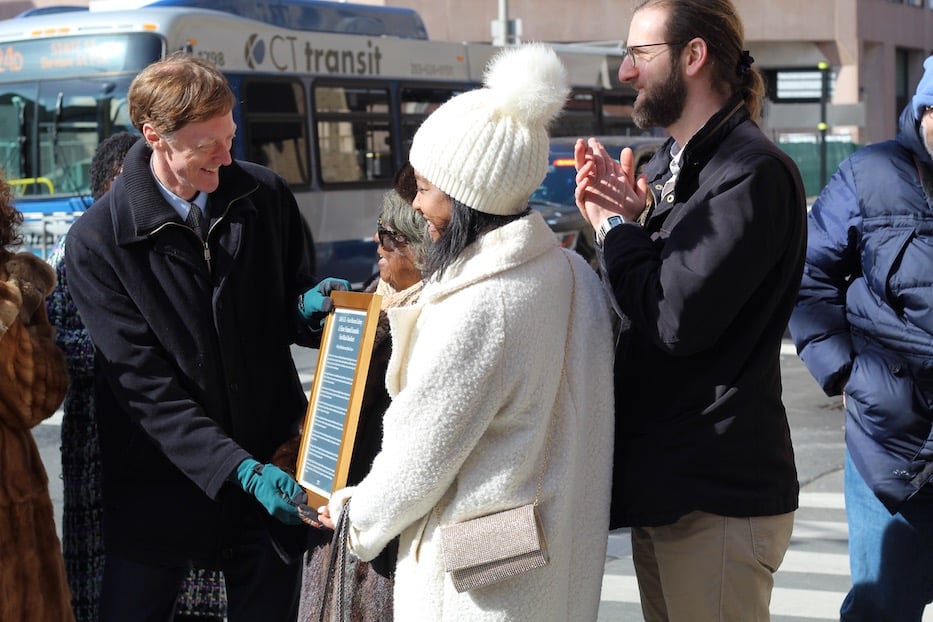
Mayor Justin Elicker with Robinson, Winter, and Tomeka Vinston. "While we've made so much progress as a nation, it is clear we have so much work to do," Elicker said. "We have so much work to do."
Monday, speakers and attendees alike marveled at the moment, which brings the city’s full and sometimes hard-to-stomach history into sharper focus. In Connecticut, slavery was legal until 1848, nearly two decades after the city voted down what would have been America’s first HBCU. In New Haven, the last recorded sale of enslaved Black people took place on the New Haven Green in 1825. Meanwhile, the 1793 creation of Eli Whitney’s cotton gin likely extended the practice of slavery in the South by decades as it increased demand for forced labor.
Now-recognized New Haven names like Theophilus Eaton, the Rev. Joseph Noyes, Theophilus Munson, Amos Morris, and Isaac Forbes all represent white, Protestant men who owned and enslaved Black people as property. In that sense, the renaming is also part of coming face-to-face with New Haven’s legacy of anti-Blackness, from urban renewal and eminent domain to officers’ use of force on Randy Cox last summer.
“I really do feel graced and grateful that we’ve been able to do this together,” said Winter, who is now the city’s director of climate and sustainability. “It’s a sign, but it’s much more than that … it’s about reclaiming, making a claim on the public space. It’s about the stories that we choose to tell. That’s a blessing for all of us, but it’s also a responsibility.”
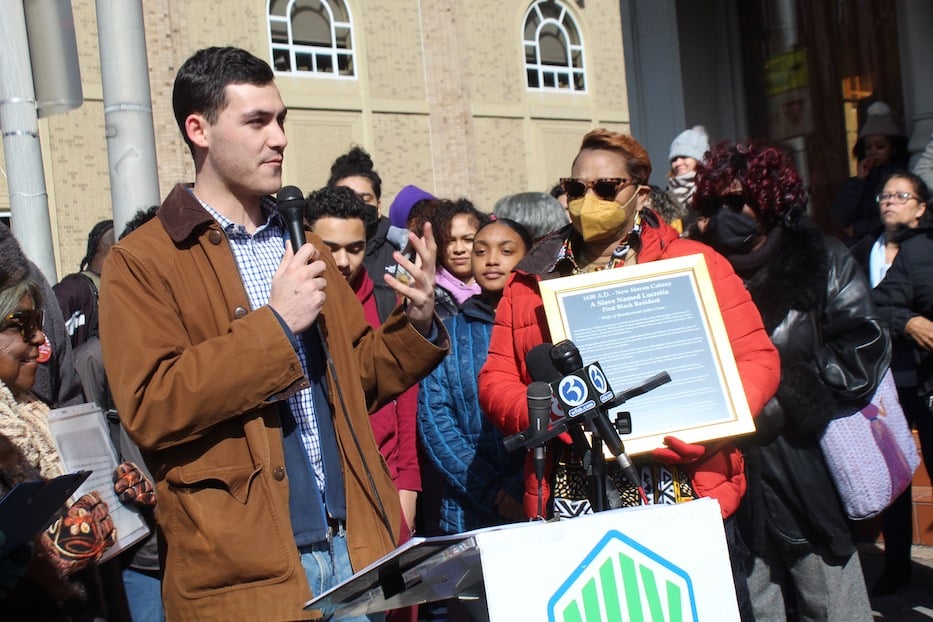
Eli Sabin. To his right, holding the plaque, is Joy Flynn.
Motioning to the high school students in attendance, Downtown/East Rock Alder Eli Sabin—who has known Robinson since he was in preschool with her grandson—called the renaming a teachable moment. For him, it’s a reminder that there is so much New Haven history that residents still don’t talk about, in part because they do not know.
Robinson herself is the first to say that she did not know about slavery in the North until she moved to New Haven from Greenville, North Carolina.
"This is a great moment to pass on our history to the next generation, so we can all understand where we come from as a city," Sabin said. "Lucretia was a slave, and that is something that we need to reckon with—that history, that was happening right here, in the downtown of our community."
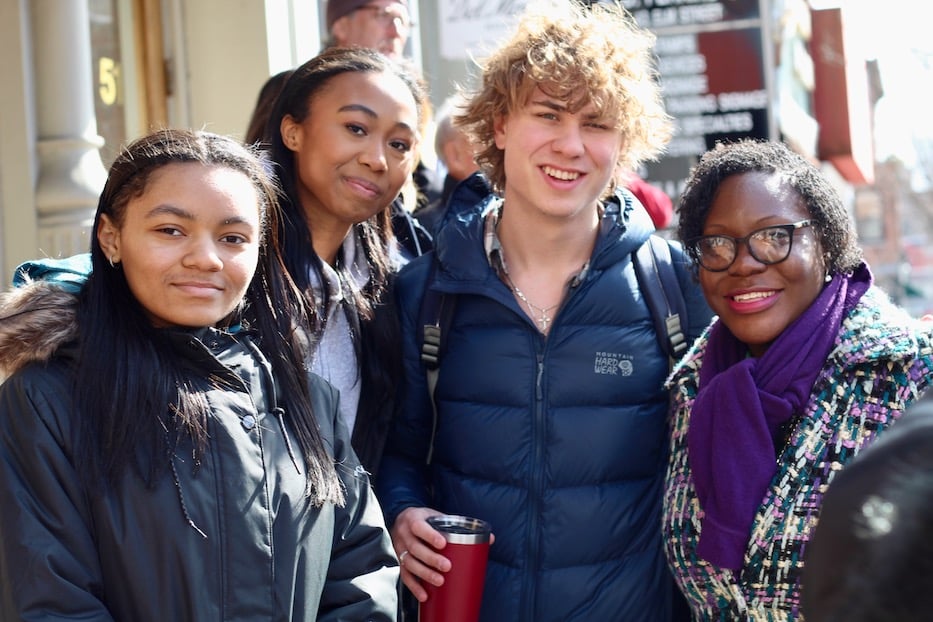
Tatiana Alicea, Aria Keane, Alec Pederson and Dr. Kelly K. Hope.
As they gathered to watch the renaming, New Haven Academy (NHA) juniors Aria Keane, Tatiana Alicea and Alec Pederson said they were excited to be part of that evolving city history. All three are students in the school’s African American Literature elective, as are dozens of their peers who came out Monday. This week, they are starting Zora Neale Hurston’s 1937 Their Eyes Were Watching God, in which Janie Crawford’s own path to self-discovery may resonate with the moment.
Alicea, who is Black and Puerto Rican, said she was grateful for the chance to see New Haven history in the making. This year, she opted to take the class because she doesn’t talk that much about Black history or culture at home, where she lives with her dad. No one taught her about the New Haven heroes and sheroes who walked the city streets long before she did.
“It feels good to be a part of history and something that has been neglected for so long,” she said.
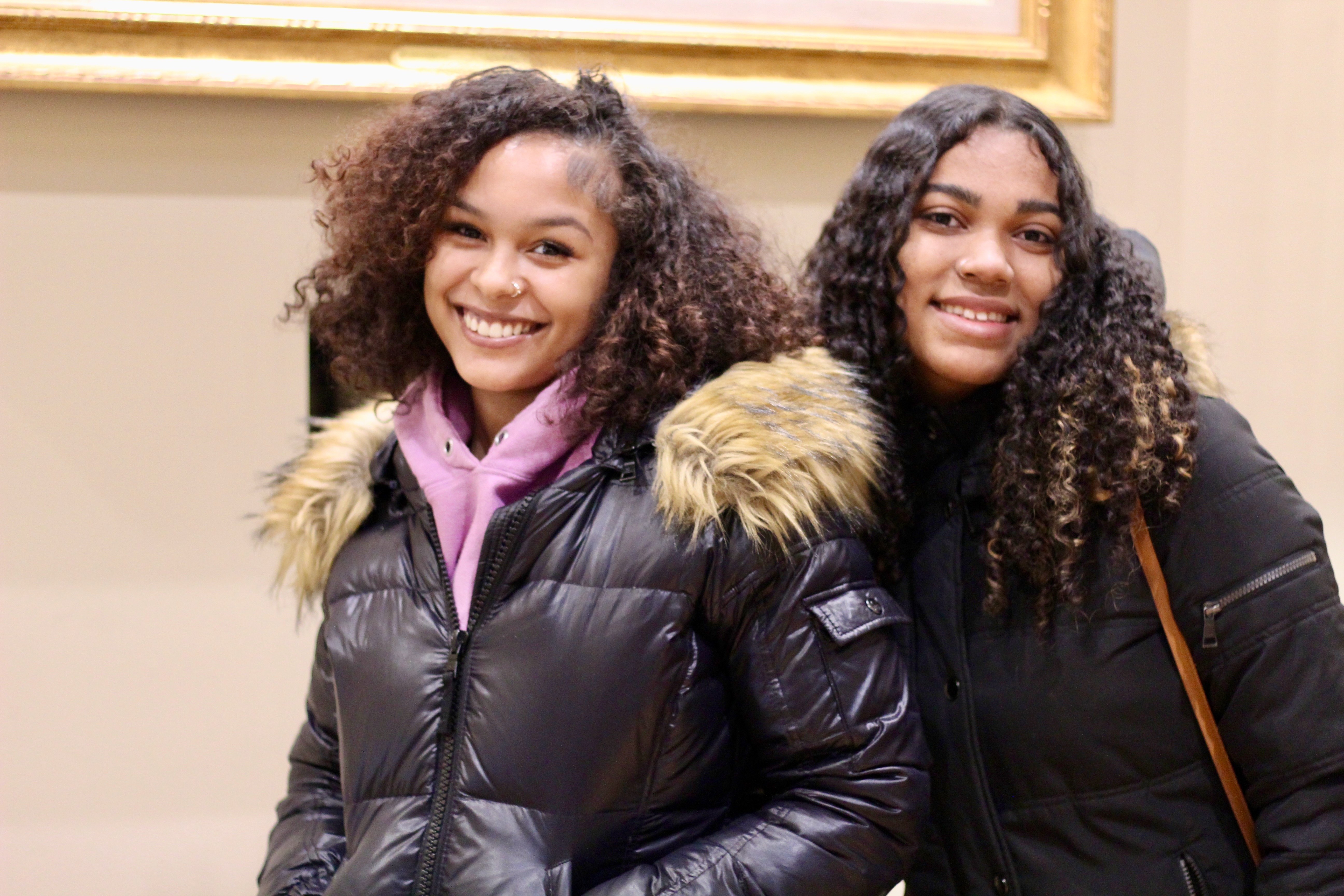
Azaria Green and Zakiya Osbourne, both juniors at New Haven Academy.
Inside City Hall for the second portion of the event, fellow NHA juniors Azaria Green and Zakiya Osbourne stressed the importance of representation. Growing up, Green didn’t know that slavery was once legal in New Haven, or that Black people had a rich and centuries-deep legacy in the city that stretched back to the 17th century. She said she’s glad to see more Black people mentioned and memorialized by name.
“People are going to look at the corner and be like, ‘Who is Lucretia?’ and look it up,” she said.
“It’s representation,” Osbourne chimed in, adding that it makes her feel more connected to the city she calls home. “From now on, I’m going to think about it [the history] when I see it.”
“We Stand On The Shoulders Of Ms. Lucretia”
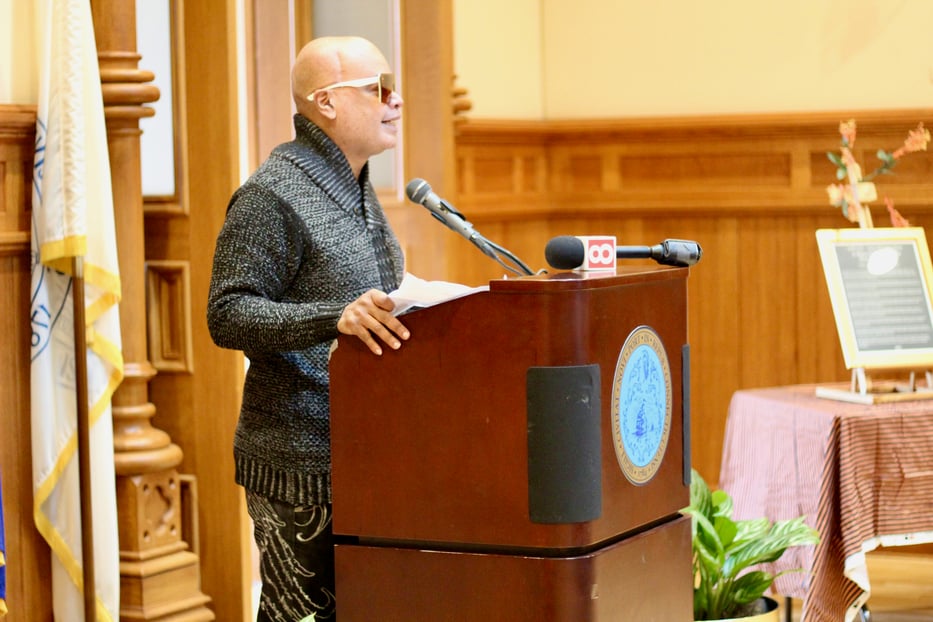
Sean Hardy, who served as the Master of Ceremonies Monday at City Hall.
That praise continued for well over an hour at City Hall, as speakers thanked Robinson for her efforts, and described Lucretia’s Corner as a step in telling New Haven’s whole story.
Dr. Kelly K. Hope, who now teaches English and Literature at New Haven Academy, pointed to the significance of a real, physical space for New Haveners to see, celebrate, and learn from their history. As a kid growing up in New Haven, she didn't have those examples, she said. In school, she learned that slavery was a Southern practice in which the North did not participate.
It was only later, when she went on to college and graduate school, that she learned a much more nuanced history. The corner is now part of that—and will remain a teachable moment for not just her students, but generations to come.
“It cements and affirms the role of Black women in the place that I call home,” she said.
Retired Probate Judge Clifton Graves told the story of his great-great-great aunt Henrietta, who was stolen from her home in West Africa and forced into slavery in the South. Enslaved by the Lash family, she was forced to work as a cook, where she could see firsthand the wealth and comfort in which white people lived as enslaved Black people suffered.
Henrietta “wasn’t the name her momma and daddy gave her,” Graves said to knowing nods across the room. And yet, she resisted in a way that she could.
Aware that it cost her her life, she began to cook extra portions of food and store them in the kitchen’s cabinets. At the end of each day, she took the food back to her family, including those who had been forced to labor without pause or compensation. When slavery ended in the 1860s, she kept the Lash name—and passed her story down to Graves’ grandmother, who passed it on to him.
“Today, we stand on the shoulders of Ms. Lucretia,” he said. He added that Lucretia now stands among New Haven’s Black trailblazers, including Constance Baker Motley and William Lanson.
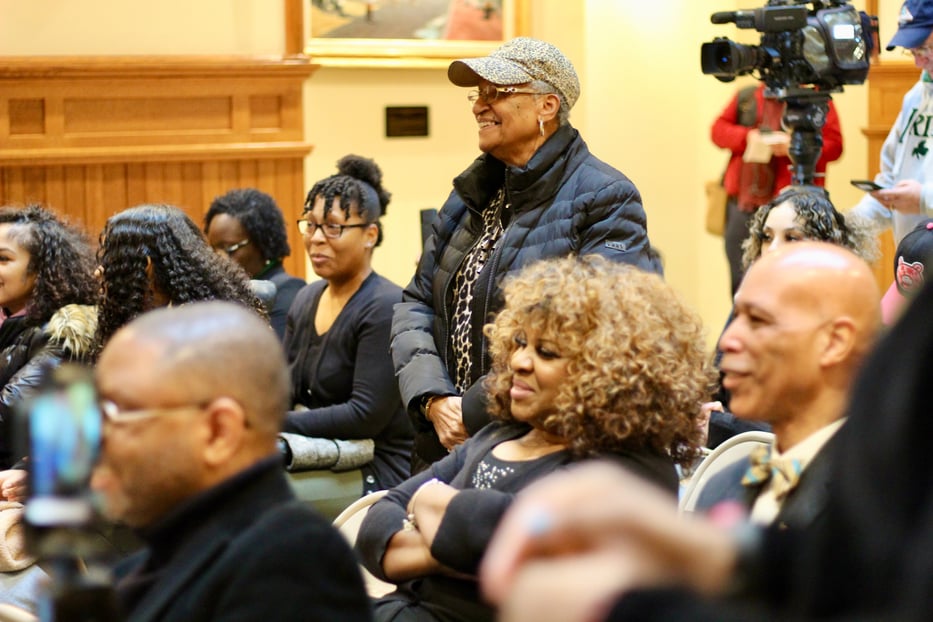
Robinson recognized Jacqueline Bracey for her work.
Michael Morand, the director of community engagement at the Beinecke Rare Book and Manuscript Library, called the renaming an important step in the truth-telling that “is necessary for repair and reconciliation.”
Quoting W.E.B. DuBois—who for a few years called New Haven his home—he praised Robinson for doing “history worthy of grown folk,” and reminding her fellow New Haveners that there is still so much to do.
Pulling out a 1748 map of New Haven, he pointed to Eaton’s former estate, which a century later belonged to Rev. Joseph Noyes. In his lifetime, Noyes enslaved at least four people. New Haveners don't yet know their names.
“There are more stories to be told,” he said, presenting Robinson with a facsimile of James Weldon Johnson’s “Lift Every Voice and Sing” annotated in the writer’s original hand. “The great work, the generative work, is not done.”
Robinson, in return, singled out community members who made sure she was never working alone. They include Jacqueline Bracey, Joy Flynn and Trina Green, who made Sam Cooke’s “A Change Is Gonna Come” her own—and New Haven's—before the morning was over.
Flynn, who has known Robinson for decades and worked with her to collect signatures, called it part of giving back. Like Robinson, Flynn’s mother is also a transplant from Greenville, North Carolina. She was a social worker, instilling in her daughter the value of service from a young age.
Green, Robinson’s goddaughter and former student, said that she was glad to grace the morning with song. Before the end of ceremonies at City Hall, she led attendees in “We’ve Come This Far By Faith.” It was just past noon, and rafter-raising sound filled the second floor atrium of the building.
“It means a lot,” she said afterwards. “Delayed doesn’t mean denied."
For more from Monday's renaming, watch the video above.

